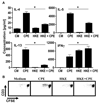Targeting Toll-like receptors on dendritic cells modifies the T(H)2 response to peanut allergens in vitro
- PMID: 20538332
- PMCID: PMC2902661
- DOI: 10.1016/j.jaci.2010.04.003
Targeting Toll-like receptors on dendritic cells modifies the T(H)2 response to peanut allergens in vitro
Abstract
Background: Delivery of allergens with bacterial adjuvants has been shown to be a successful immunotherapeutic strategy for food allergy treatment in animal models. How microbial signals, acting through the innate immune system, reshape ongoing allergic responses is poorly understood.
Objective: To investigate the contribution of Toll-like receptors (TLRs) in the response to bacterial adjuvants, we designed an in vitro system to characterize the effect of heat-killed Escherichia coli vector (HKE) on peanut-induced responses of dendritic cells (DCs) and T cells.
Methods: Wild-type or TLR signaling-deficient bone marrow-derived DCs were pulsed with crude peanut extract (CPE) alone (50 microg/mL) in the presence of HKE (10(6)/mL). DC maturation was analyzed by means of flow cytometry. Treated DCs were cocultured with carboxyfluorescein succinimidyl ester (CFSE)-labeled CD4(+) T cells from sensitized mice. Cytokine production from DCs and T cells was measured by using Bioplex assays.
Results: Peanut-pulsed DCs induced the production of IL-4, IL-5, and IL-13, as well as IL-17 and IFN-gamma, from primed T cells. Adding HKE to CPE-pulsed DCs resulted in a significant decrease in T(H)2 cytokine production associated with an increase in IFN-gamma levels and profound attenuation of T-cell proliferation. These effects were linked to HKE-induced TLR-dependent changes in DC reactivity to CPE, especially the production of polarizing cytokines, such as IL-12.
Conclusions: TLR signals modulate peanut-induced DC maturation in vitro, leading to changes in the T-cell response to peanut. These TLR effects must be confirmed in vivo and might constitute another alternative for allergen immunotherapies.
Copyright 2010 American Academy of Allergy, Asthma & Immunology. Published by Mosby, Inc. All rights reserved.
Figures






Similar articles
-
Purified Free Mannan Promotes Tolerogenic Responses in Peanut-Stimulated Human Dendritic Cells.Int Arch Allergy Immunol. 2024;185(7):652-658. doi: 10.1159/000537989. Epub 2024 Mar 21. Int Arch Allergy Immunol. 2024. PMID: 38513626
-
T cell responses to major peanut allergens in children with and without peanut allergy.Clin Exp Allergy. 2010 Apr;40(4):590-7. doi: 10.1111/j.1365-2222.2009.03431.x. Epub 2010 Jan 11. Clin Exp Allergy. 2010. PMID: 20067479
-
Disruption of T-cell immunoglobulin and mucin domain molecule (TIM)-1/TIM4 interaction as a therapeutic strategy in a dendritic cell-induced peanut allergy model.J Allergy Clin Immunol. 2008 Jul;122(1):55-61, 61.e1-7. doi: 10.1016/j.jaci.2008.04.036. Epub 2008 Jun 10. J Allergy Clin Immunol. 2008. PMID: 18547633
-
Induction of Interleukin-10 Producing Dendritic Cells As a Tool to Suppress Allergen-Specific T Helper 2 Responses.Front Immunol. 2018 Mar 19;9:455. doi: 10.3389/fimmu.2018.00455. eCollection 2018. Front Immunol. 2018. PMID: 29616018 Free PMC article. Review.
-
Current Trend in Immunotherapy for Peanut Allergy.Int Rev Immunol. 2018;37(6):279-290. doi: 10.1080/08830185.2018.1509967. Epub 2019 Jan 13. Int Rev Immunol. 2018. PMID: 30638084 Review.
Cited by
-
Intestinal epithelial barrier dysfunction in food hypersensitivity.J Allergy (Cairo). 2012;2012:596081. doi: 10.1155/2012/596081. Epub 2011 Sep 8. J Allergy (Cairo). 2012. PMID: 21912563 Free PMC article.
-
Developing therapies for peanut allergy.Int Arch Allergy Immunol. 2014;165(3):179-94. doi: 10.1159/000369340. Epub 2014 Dec 20. Int Arch Allergy Immunol. 2014. PMID: 25531161 Free PMC article. Review.
-
Expression and activation of the steroidogenic enzyme CYP11A1 is associated with IL-13 production in T cells from peanut allergic children.PLoS One. 2020 Jun 4;15(6):e0233563. doi: 10.1371/journal.pone.0233563. eCollection 2020. PLoS One. 2020. PMID: 32497050 Free PMC article.
-
Heterogeneous responses and cross reactivity between the major peanut allergens Ara h 1, 2,3 and 6 in a mouse model for peanut allergy.Clin Transl Allergy. 2015 Mar 23;5:13. doi: 10.1186/s13601-015-0056-9. eCollection 2015. Clin Transl Allergy. 2015. PMID: 25802736 Free PMC article.
-
Type B CpG oligodeoxynucleotides induce Th1 responses to peanut antigens: modulation of sensitization and utility in a truncated immunotherapy regimen in mice.Mol Nutr Food Res. 2013 May;57(5):906-15. doi: 10.1002/mnfr.201200410. Epub 2013 Feb 5. Mol Nutr Food Res. 2013. PMID: 23386314 Free PMC article.
References
-
- Bock SA, Munoz-Furlong A, Sampson HA. Fatalities due to anaphylactic reactions to foods. Journal of Allergy and Clinical Immunology. 2001;107(1):191–193. - PubMed
-
- Sicherer SH, Munoz-Furlong A, Sampson HA. Prevalence of peanut and tree nut allergy in the United States determined by means of a random digit dial telephone survey: A 5-year follow-up study. Journal of Allergy and Clinical Immunology. 2003;112(6):1203. - PubMed
-
- Sicherer SH, Burks AW, Sampson HA. Clinical Features of Acute Allergic Reactions to Peanut and Tree Nuts in Children. Pediatrics. 1998 Jul 1;102(1):e6. - PubMed
-
- Avery N, King R, Knight S, Hourihane JOB. Assessment of quality of life in children with peanut allergy. Pediatric Allergy and Immunology. 2003;14(5):378–382. - PubMed
-
- Nelson HS, Lahr J, Rule R, Bock A, Leung D. Treatment of anaphylactic sensitivity to peanuts by immunotherapy with injections of aqueous peanut extract. Journal of Allergy and Clinical Immunology. 1997 Jun;99(6, Part 1):744–751. - PubMed
Publication types
MeSH terms
Substances
Grants and funding
LinkOut - more resources
Full Text Sources
Other Literature Sources
Research Materials
Miscellaneous

